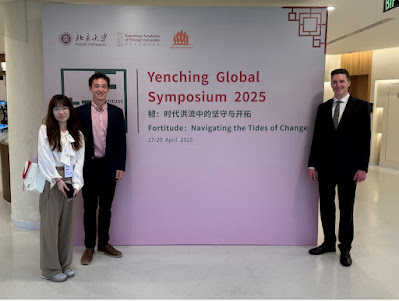Student blogger Cady Deck, Certificate ’19, shares her experience participating in a research trip for the Hopkins-Nanjing Center course Chinese and American Thought: Bilingual Perspectives.
 |
| My group on top of Shika Snow Mountain in Shangri-La |
Over fall break, I went to Yunnan Province to conduct research with classmates from the course Chinese and American Thought: Bilingual Perspectives. This was an opportunity that I didn’t even know existed before coming to the Hopkins-Nanjing Center. There are other classes offered during the school year that include research trips, which I think is something that makes the Hopkins-Nanjing Center experience unique.
For a couple of weeks before the trip, we learned about the area in Yunnan known as Shangri-La and its characteristics, including religions, myths, and ethnic diversity. The class then split into three groups, focusing on either the myth of Shangri-La, Tibetan Buddhism in Shangri-La, or ethnic minorities in Shangri-La. Each international student was paired with a Chinese student and each pair determined their own subtopic based on one of the three broader subject areas. We worked together during the research trip to conduct interviews, compile notes, and decide where to go. After coming back to Nanjing, we worked with our partner and our group to give presentations to the community about our findings. We also wrote research papers detailing our research methods, preconceptions, findings, and conclusions.
In many ways, learning about Shangri-La firsthand was more valuable than learning about it in the classroom. We spent the week interviewing locals, shop owners, and tourists. In our small groups, we were given the freedom to decide where we wanted to go, what we wanted to do, and how we wanted to do it. Because we had a full day in Kunming and my group was researching ethnic minorities, we decided to go to the Yunnan Nationalities Museum. The museum was interesting and informative, but the best part was running into an entire group of Miaozu men and women who were also exploring the museum. We interviewed several of the women about their lives in Yunnan and discovered that they were in Kunming as part of a government program to learn the sewing techniques of other ethnic minorities.
 |
| Students with Miaozu men and women in front of Yunnan’s Nationalities Museum in Kunming |
After Kunming, we flew to Shangri-La. When we arrived, we rested and adjusted to the altitude, which is over 10,000 feet above sea level, before going out to explore the area. One of the local places we went was Dukezong, Shangri-La’s ancient town. We interviewed some local shopkeepers about living and working in the area. One Yizu woman described to us how she continued to preserve her own culture while living in Shangri-La, which is 80% Tibetan Buddhist. Although it’s fairly touristy, there is a large temple, an entire area of housing, and a lot of different ethnic minorities, which reflects the diversity of Yunnan and Shangri-La itself.
 |
| One of the groups at a temple in Shangri-La |
In addition to visiting the ancient town, the three groups went to many other places to do research and see some of the famous sites. Songzanlin Temple is the largest Tibetan Buddhist Temple in Yunnan Province and one of the most famous in China. My group interviewed several monks, the tour guide, and a couple older Naxizu women selling sour yak yogurt. One of the monks told us that although this temple is a major tourist destination, the tourist industry hasn’t really impacted the monks’ way of life.
 |
| Two groups at Songzanlin Temple in Shangri-La to learn about Tibetan Buddhism |
Two groups went to the Bureau of Religious Affairs to see what information they could learn about the region related to religion and ethnic minorities. Another group went to Potatso National Park to interview tourists and analyze the myth of Shangri-La. They then compared their findings to James Hilton’s novel Lost Horizon, which we read for class before the trip.
 |
| A group at Potatso National Park to interview tourists and locals about the myth of Shangri-La |
To explore the area, several groups went to Shika Snow Mountain and Balagezong Canyon, which were both beautiful and educational. At the bottom of Shika Snow Mountain, my partner and I interviewed two Tibetan women who were living nearby and raising yak until the winter. At Balagezong Canyon we managed to get a private guide who drove us around and introduced the history of the region. In addition to taking us to all of the various scenic spots, he also shared with us his experiences growing up in the area and how development has changed it in the past few decades. For example, he used to go to school by horse and cart, but a rich former resident poured money into the area and built a lot of the roads, making the area more accessible to residents and visitors.
 |
| A fun trip to Balagezong Canyon |
This trip was also a great opportunity to bond with all of my classmates, but especially my Chinese classmates, outside of the Hopkins-Nanjing Center bubble. Going to class together two times every week for two hours is one thing, but spending a week traveling with a group of people is a completely different experience. Since coming back from the trip, I’ve noticed that the class dynamics have changed in a positive way. People who were merely classmates before are now close friends and as a result, conversations in class flow much more smoothly. There are also other classes that include a research trip component, both weekend trips and entire week trips during the fall and spring breaks. I highly recommend taking one of these classes because it added so much to my experience here, both intellectually and personally.
Written by Cady Deck, Certificate ‘19








